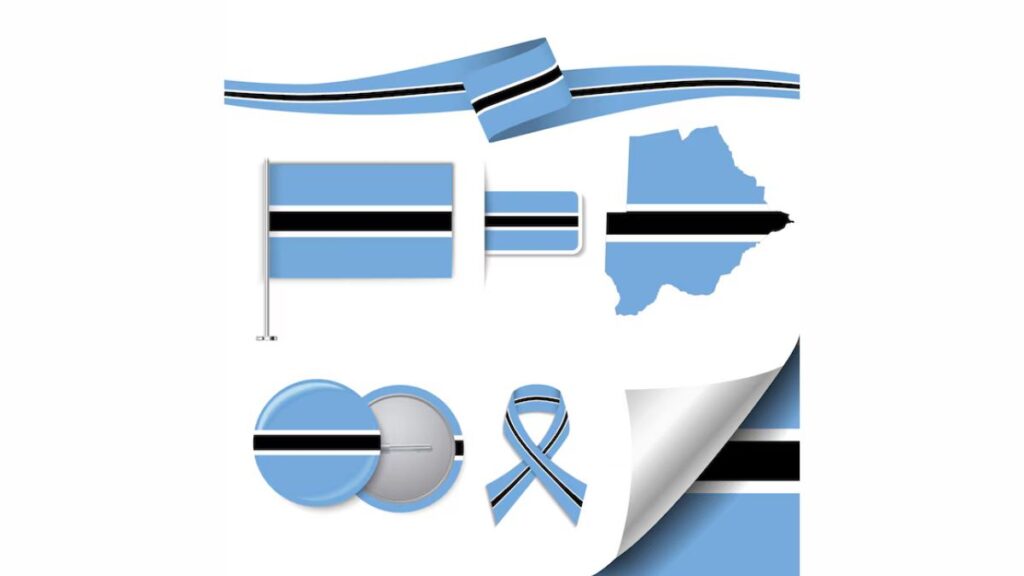The flag of Botswana is an emblem of the nation’s pride, history, and identity. It represents more than just a visual symbol; it is a reflection of the country’s past struggles, aspirations, and commitment to peace and unity. In this article, we’ll explore the flag’s design, historical significance, and what each element represents, providing you with a comprehensive understanding of this iconic flag. We’ll also delve into how it compares to other flags from African nations.
The Design of the Flag of Botswana
Adopted on September 30, 1966, following Botswana’s independence from the United Kingdom, the flag of Botswana features a unique design and color scheme. The flag consists of three horizontal stripes in a simple yet meaningful arrangement.
Breakdown of the Flag’s Colors
- Light Blue: The flag’s primary color is light blue, representing the country’s wealth of water resources, its peaceful nature, and the sky that covers the nation.
- Black and White Stripes: In the center of the flag are two horizontal black and white stripes. The black stripe symbolizes the country’s African heritage, while the white stripe represents the nation’s other ethnic communities, emphasizing Botswana’s unity in diversity. The black and white stripes also signify the harmonious coexistence of these groups.
- The Wavy Line: The wavy line in the center of the flag symbolizes the Okavango River, one of Botswana’s most important and distinctive natural features. The river plays a central role in the ecological and cultural landscape of Botswana, and the wavy line embodies the country’s connection to nature.
The design is minimalist yet powerful, embodying the key values that define Botswana as a nation: unity, peace, and respect for its environment.
Historical Significance of the Flag of Botswana
Independence and National Identity
Before Botswana’s independence, the country was known as the British Protectorate of Bechuanaland. The nation was granted independence on September 30, 1966, and the flag was chosen as a symbol of the newly independent country. The creation of the flag was a pivotal moment in the development of Botswana’s national identity.
The choice of colors and symbols was made to resonate with both the historical context and the aspirations of the people. The black and white stripes were a direct reflection of Botswana’s commitment to racial equality and social harmony. The light blue color was a nod to the country’s peaceful and stable existence, which was essential to their governance model.
The Flag’s Role in National Pride
Since its adoption, the flag of Botswana has become a symbol of national pride and unity. It is raised at every significant public event, government office, and on all official occasions, signifying the continuity of Botswana’s national values. Over the years, the flag has come to represent a peaceful and prosperous country, one that maintains its commitment to democracy and inclusivity.
Botswana’s Heritage and Unity
Botswana’s flag plays an essential role in conveying the country’s philosophy of unity, peace, and equality. It shows that despite the ethnic and cultural diversity within Botswana, there is a collective national identity. In a region that has historically seen division, the flag stands as a reminder that peaceful coexistence and mutual respect are possible. This message of unity resonates strongly with Botswana’s post-independence political structure, which emphasizes democratic governance and social harmony.
Symbolism Behind the Flag’s Elements
Each element of the flag has a specific and profound meaning:
The Light Blue Color
The light blue in the flag symbolizes Botswana’s peaceful nature. It reflects the country’s commitment to maintaining peace, both internally and externally. This color also stands for the sky and water, which are vital to Botswana’s landscape, particularly in the arid Kalahari Desert region.
The Black and White Stripes
The black and white stripes symbolize the harmony between Botswana’s different ethnic groups. The black stripe represents the majority ethnic group, while the white stripe represents the nation’s ethnic minorities. This choice of color reflects Botswana’s inclusive nature, with a focus on national unity.
The Wavy Line
The wavy line represents the Okavango Delta, one of the world’s largest inland deltas, located in Botswana. The Okavango River is central to the nation’s ecosystem, providing water to both humans and wildlife. The wavy line, therefore, also symbolizes life and vitality, linking the flag to the natural resources that sustain Botswana’s people and environment.
Flag of Botswana: A Comparison with Other African Flags
To further understand the uniqueness of the flag of Botswana, it’s useful to compare it with other flags across the African continent. Many African flags feature symbolic colors such as green, red, and yellow, representing themes of independence, Pan-Africanism, and the struggle against colonialism. Botswana’s flag, however, stands out due to its use of blue, black, and white, which have specific ties to the country’s national identity, peace, and environmental connection.
Below is a comparative chart showcasing the flags of Botswana and a few other African nations:
| Country | Flag Design | Key Symbolism |
| Botswana | Light blue background with black and white stripes, a wavy line in the middle | Represents peace, racial harmony, and the Okavango River. |
| South Africa | Green, yellow, red, black, blue, and white with a Y-shape design | Symbolizes the diversity of the population and the country’s transition from apartheid to democracy. |
| Ghana | Three horizontal stripes (red, yellow, green) with a black star in the center | Represents the country’s struggle for independence, the wealth of its land, and its future aspirations. |
| Kenya | Three horizontal stripes (black, red, and green) with a white-edged red, black, and white shield | The black represents the people of Kenya, red for the blood shed in the fight for independence, and green symbolizes the country’s wealth and natural resources. |
| Ethiopia | Green, yellow, and red horizontal stripes with a star and crescent in the center | Symbolizes Pan-Africanism, the struggle for freedom, and unity in Africa. |
Key Takeaways from the Comparison
- Uniqueness in Design: Unlike many African flags, Botswana’s flag does not follow the common use of red, green, and yellow but instead uses a combination of light blue, black, and white. This reflects Botswana’s distinct identity and peaceful nature.
- Symbolism of Unity and Peace: Botswana’s flag places heavy emphasis on peace and racial unity, which stands in contrast to the struggle for independence seen in many other African nations. While other flags like Ghana’s and Kenya’s highlight the bloodshed for freedom, Botswana’s flag focuses on harmony and mutual respect.
- Environmental Connection: The wavy line on Botswana’s flag is a significant feature that ties the country’s identity to its natural landscape, particularly the Okavango River, something few African flags focus on.
The Role of the Flag in Modern Botswana
The flag of Botswana continues to be a powerful symbol of the nation’s sovereignty and pride. It is used in various settings, including government offices, national holidays, sporting events, and other public gatherings. The flag fosters a sense of national unity among the citizens, especially on national celebrations such as Independence Day.
The Flag’s Educational Role
In schools across Botswana, the flag is used as a teaching tool to instill a sense of national identity in young citizens. By understanding the flag’s colors and symbols, children learn about their country’s history, values, and the importance of living in peace and unity with each other.
The Flag’s International Significance
On the international stage, the flag of Botswana serves as a representation of the country’s values. In diplomatic forums, peacekeeping missions, and sporting events, the flag is a symbol of Botswana’s commitment to peaceful resolution, democracy, and human rights.
Conclusion
The flag of Botswana is more than just a national symbol; it is an embodiment of the country’s identity, its rich history, and its future aspirations. Through its simple yet powerful design, it communicates messages of peace, unity, and respect for the environment. From its adoption following independence to its ongoing role in uniting the nation, the flag serves as a constant reminder of Botswana’s journey towards a peaceful and prosperous future.
Whether you are a student, a visitor, or simply someone interested in the rich history of African flags, understanding the significance of the flag of Botswana gives insight into the nation’s values and the cultural harmony it has worked to achieve. It is a flag that tells a story of resilience, unity, and pride.
By examining its symbolism, history, and comparison with other African flags, it’s clear that the flag of Botswana stands as a beacon of peace and national unity in the heart of Southern Africa.







